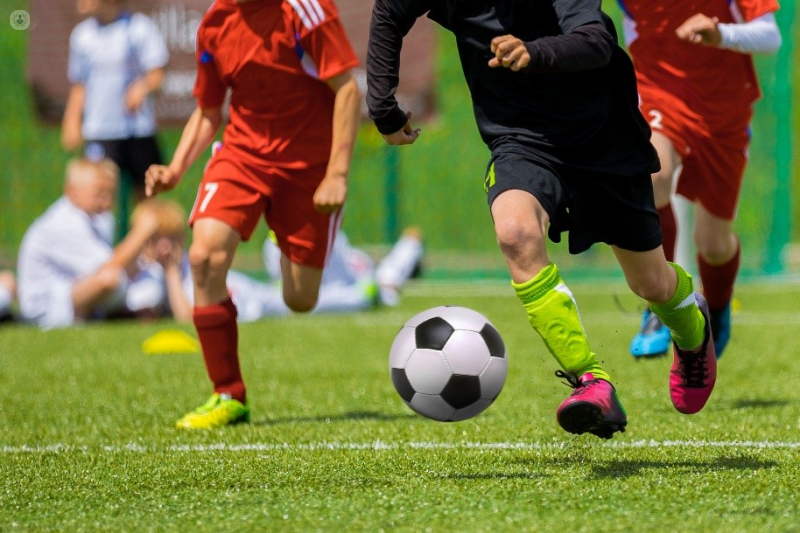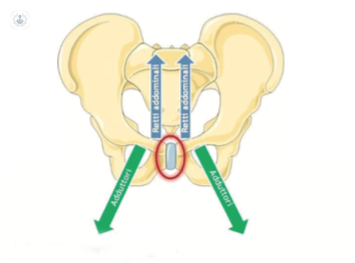Do I have Gilmore’s Groin or a sports hernia? I can't feel a lump!
Escrito por:Gilmore’s Groin, athletic pubalgia (AP), sports hernia and pubic inguinal pain syndrome are all terms used to describe a spectrum of injuries that involve the muscle, tendon and ligaments that make up a dense connective tissue fascia that anchors the pubic bone and inguinal region (the lower part of the abdomen that connects with the groin). It’s a common cause of groin and adductor pain in athletes involved in sports that require kicking and pivoting like soccer or ice hockey.
Orthopaedic surgeon Mr Rishi Chana tells us more about sports hernia and what it feels like.

The groin itself has the interesting dilemma of these two muscle groups potentially fighting “against” each other by leveraging on the same fixed points but in opposing directions.

Gilmore’s initial description was of a complex injury including tearing of the external oblique aponeurosis (outer abdominal muscles that extend from the lower ribs to the pelvis) with conjoint tendon disruption and tearing of the pubic tubercle, most commonly associated with disruption of the rectus tendon attached to the pubis. The rectus femoris muscle is the large quadriceps muscle that runs down the centre of the front of the thigh. This tendon can rupture due to any activity that exerts pressure and strain, like sprinting or kicking a ball.
There could also be concurrent weakening of the posterior inguinal wall. This may explain the initial “niggling” injury progressively worsening with or without a hernia. Sharp pain would be experienced in the groin area when performing certain movements like twisting and turning.
Ellatar hypothesized the cause of sports hernia to be due to an imbalance between the pull of the more powerful adductors against the abdominal wall muscles leading to shearing of the latter. If you think about a kick, the forces translate to pulling against a fixed leg with the mechanical torsion being greater across the abdomen.
What does a sports hernia feel like?
Typical symptoms are a sharp pain in the pubic bone region or near this area that can radiate up into the abdominal muscles or down into the inner thigh. Running, twisting, coughing, sneezing and anything that increases abdominal straining or rapid rotations aggravates the condition.
Many sporting athletes say they cannot continue with their activities due to pain, even sitting up can cause grief.
What can I do about it?
See a specialist! The diagnosis and ruling out of other causes are key. An orthopaedic hip specialist and physiotherapist can help with guidance and advice after examination and a look at your medical history. An MRI will also confirm the diagnosis. You may need an injection for pain relief followed by the regime below:
Core strengthening
The muscles to be strengthened are the core muscles and include the transversus abdominus (muscles to the front and side of the abdomen) and multifidus (deep muscle along the back of the spine, close to the midline). These act as stabilising muscles for the trunk and pelvis before movement of the arms and legs occurs. The transversus abdominus muscle stabilises the trunk by acting as a natural corset and the multifidus muscles run along the spine attaching to the vertebrae.
Groin strengthening
It is also important to strengthen the groin muscles, known as the adductors. There are both short and long adductor muscles and so these exercises should be performed with the knee both straight (long adductors) and bent (short adductors) to work both sets.
Whilst core strengthening is performed initially, these exercises can begin as soon as they are pain-free to perform. Start very gently, allowing plenty of recovery time (2 days initially) between sessions. If there is pain, then stop immediately
Stretching exercises
Stretching for Gilmore's groin should aim to maintain or improve the flexibility at the hip joint as a whole. Therefore it's important to stretch not only the groin muscles but also the hip flexors, hamstrings and glutes.
Standing groin stretch
Stand with a wide stance. Bend the knee of the leg you are not stretching and lean towards that side. You should feel a stretch on the inside of the straight leg. Hold for 20-30 seconds and repeat 2-3 times. This exercise stretches the long adductor muscles.
Short adductor stretch
Sit on the floor and place the soles of your feet together. Place your elbows on your knees and apply downward pressure until you feel a stretch on the inner groin. Hold for 20-30 seconds and repeat 2-3 times.
Hip flexor stretch
Place one knee on the floor and the other foot flat on the floor in front of you. Push your hips forward, keeping your back upright, until you feel a stretch at the front of the hip. Hold for 20-30 seconds and repeat 2-3 times.
Hamstring stretch
Sit on the floor with the back upright. Lean forward from the hips until you feel a stretch in the hamstrings at the back of the thigh. Hold for 20-30 seconds and repeat 2-3 times.
Gluteal stretch
Lay on the floor on your back. Bring your knee up towards your chest. Pull the knee in towards you and across your body, towards the opposite shoulder. You should feel a stretch in the buttock. Hold for 20-30 seconds and repeat 2-3 times.
Strengthening exercises
Below are strengthening exercises used in the rehabilitation of Gilmore's Groin injury following surgery. Always seek professional advice before starting any rehabilitation program.
Strengthening the transversus and multifidus muscles
Kneel on all fours. Relax and allow the stomach to sag down. Very gently pull in your tummy so that your belly button moves closer to your spine. Do not contract too hard or other muscles will come into play. You should be able to hold this contraction whilst breathing or having a conversation. Begin by holding the contraction for 5 seconds, repeat 20 times.
Perform this exercise twice a day. Gradually increase the duration of contraction up to 10 seconds. To take the exercise still further, perform the static contractions in other positions such as sitting or standing.
Crunches
Lie on your back with the knees bent. Slide your hands up your thighs to your knees, then hold for 5 seconds. Alternatively, you can place your hands on your temples. Repeat 6 times.
Single leg raise
In a sitting position, raise the straight leg a few inches off the floor. Hold for 5 seconds before slowly lowering the leg back down. Repeat 10 times. This exercise can be progressed by moving the leg out to the side.
Static groin contraction
The first place to start when strengthening the groin is with static contractions. Place a ball between the knees and squeeze inwards, hold for 5-10 seconds, rest and repeat. You should also do this with straight legs and the ball between the ankles to work the long adductors.
Hip adduction holds
Lay on your side, with your trunk straight, with the top leg rested on a chair. Raise the lower leg off the floor, keeping the knee straight. Lift as high as you can, hold for 5 seconds and lower back to the floor.
Lunges
Stand with a wide stance, one leg in front of the other. Bend the back knee down towards the floor and the front knee forwards over your foot. Keep your back upright throughout. Stop before the back knee touches the floor. Perform 5-10 reps. Progress to lunging forward, holding a ball between outstretched arms and then twist in alternate directions, right then left.
Ball rolls
Lay on your back with a Swiss ball between your bent knees. Spread your arms out on the floor for balance. Roll first to the left then to the right. Repeat 10 times (5 each side).
Is Surgery Always Necessary?
No, the majority of people get better with the above treatment, but some bigger tears and defects require a mesh reconstruction.
If you believe you may have a sports hernia or Gilmore’s groin, schedule an appointment with Mr Chana and have it seen to right away.


